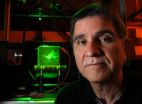(Press-News.org) November 4, 2010 – The autoimmune disease type 1 diabetes (T1D), also known as juvenile diabetes, is diagnosed in approximately 70,000 children worldwide per year. Genetics is increasingly being recognized as playing a significant role in susceptibility to the disorder, but outside a handful of genes, a clear understanding of the genetic architecture that underlies T1D has remained elusive. In a study published online today in Genome Research (www.genome.org), scientists have identified a novel gene associated with diabetes in mice that is revealing new clues about genomic mechanisms that could underlie T1D susceptibility.
Genome-wide association studies (GWAS), genetic scans that look for variants that occur more frequently in people with a certain trait or disease, have recently uncovered more than 40 regions of the genome associated with T1D susceptibility. However, because of the diversity of the human population, isolating the genetic variants that actually cause the disease has been a challenge for researchers.
To avoid the complication of genetic diversity, a team of researchers in Australia have used selective breeding of a non-obese diabetic (NOD) mouse strain to narrow down one of 25 genomic regions associated with increased risk for diabetes to a single gene of unknown function, called AK005651. "We actually got a bit lucky in identifying a mouse gene that hadn't been studied before," said Thomas Brodnicki of St. Vincent's Institute of Medical Research, senior author of the study.
Brodnicki described how selective mouse mating in inbred strains shuffles small pieces of DNA between mice, analogous to shuffling a deck of cards, that will reveal which piece of DNA encodes a disease-related gene. "In our case, a unique chromosome feature, called a recombination hotspot, stacked the DNA deck in favor of finding this gene," Brodnicki noted.
Genetic recombination is the process during cell division in which DNA regions are broken and rejoined, a mechanism beneficial in creating genetic diversity. However, there is also a risk that recombination will generate deleterious alleles. "This particular hotspot actually changed the identified gene's DNA makeup so that it altered diabetes onset in certain mice," Brodnicki said, explaining how the DNA sequence variations in AK005651 were associated with decreased expression of the gene in the thymus and spleen of diabetic mice.
Brodnicki added that it is not yet clear if the mouse diabetes gene has an equivalent in humans, and exactly how the gene confers T1D susceptibility remains unknown. "Our work does demonstrate that recombination hotspots, which have been relatively neglected in recent genetic studies, should be investigated further for their ability to produce DNA changes in genes that can affect one's risk for developing common polygenic diseases, such as type 1 diabetes."
INFORMATION:
Scientists from the St. Vincent's Institute of Medical Research (Fitzroy, Australia), The University of Melbourne (Parkville, Australia), The Walter & Eliza Hall Institute of Medical Research (Parkville, Australia), The Western Australian Institute of Medical Research (Perth, Australia) contributed to this study.
This work was supported by the Juvenile Diabetes Research Foundation, the Cooperative Research Centre for Discovery of Genes for Common Human Diseases, the National Health and Medical Research Council (Australia), and the National Institutes of Health/National Institute of Diabetes and Digestive and Kidney Diseases (USA).
Media contacts:
The authors are available for more information by contacting Anne Johnston, Press Officer for St. Vincent's Institute of Medical Research (+61 3 9288 2484; ajohnston@svi.edu.au).
Interested reporters may obtain copies of the manuscript from Peggy Calicchia, Editorial Secretary, Genome Research (calicchi@cshl.edu; +1-516-422-4012).
About the article:
The manuscript will be published online ahead of print on November 4, 2010. Its full citation is as follows:
Tan IKL, Mackin L, Wang N, Papenfuss AT, Elso CM, Ashton MP, Quirk F, Phipson B,
Bahlo M, Speed TP, Smyth GK, Morahan G, Brodnicki TC. A recombination hotspot leads to sequence variability within a novel gene (AK005651) and contributes to type 1 diabetes susceptibility. Genome Res doi:10.1101/gr.101881.109.
About Genome Research:
Launched in 1995, Genome Research (www.genome.org) is an international, continuously published, peer-reviewed journal that focuses on research that provides novel insights into the genome biology of all organisms, including advances in genomic medicine. Among the topics considered by the journal are genome structure and function, comparative genomics, molecular evolution, genome-scale quantitative and population genetics, proteomics, epigenomics, and systems biology. The journal also features exciting gene discoveries and reports of cutting-edge computational biology and high-throughput methodologies.
About Cold Spring Harbor Laboratory Press:
Cold Spring Harbor Laboratory is a private, nonprofit institution in New York that conducts research in cancer and other life sciences and has a variety of educational programs. Its Press, originating in 1933, is the largest of the Laboratory's five education divisions and is a publisher of books, journals, and electronic media for scientists, students, and the general public.
Genome Research issues press releases to highlight significant research studies that are published in the journal.
Recombination hotspot stacks the DNA deck in finding a new diabetes susceptibility gene
2010-11-04
ELSE PRESS RELEASES FROM THIS DATE:
New compounds may treat both alcohol and cigarette addictions
2010-11-04
Researchers at the Ernest Gallo Clinic and Research Center at the University of California, San Francisco, and Pfizer Inc., have determined that two new compounds may be effective in treating both alcohol and nicotine dependence at the same time.
In a paper published in the November 3, 2010 issue of Neuropsychopharmacology, the researchers showed that alcohol consumption in rodents was significantly decreased by two compounds that target neuronal nicotinic acetylcholine receptor (nAChR) subtype 34*.
nAChRs are proteins found in the brain and broader ...
Moving holograms: From science fiction to reality
2010-11-04
Remember the Star Wars scene in which R2D2 projects a three-dimensional image of a troubled Princess Leia delivering a call for help to Luke Skywalker and his allies? What used to be science fiction is now close to becoming reality thanks to a breakthrough in 3D holographic imaging technology developed at the University of Arizona College of Optical Sciences.
A team led by optical sciences professor Nasser Peyghambarian developed a new type of holographic telepresence that allows the projection of a three-dimensional, moving image without the need for special eyewear ...
Gladstone scientists identify process by which Alzheimer's disease creeps through the brain
2010-11-04
SAN FRANCISCO, CA – November 3, 2010—Scientists at the Gladstone Institute of Neurological Disease (GIND) have offered new information about the events that underlie the "spread" of Alzheimer's disease (AD) throughout the brain. The research, published in the November 4th issue of the journal Neuron, follows disease progression from a vulnerable brain region that is affected early in the disease to interconnected brain regions that are affected in later stages. The findings may contribute to design of therapeutic interventions, as targeting the brain region where AD originates ...
UCLA autism study reveals how genetic changes rewire the brain
2010-11-04
Many gene variants have been linked to autism, but how do these subtle changes alter the brain, and ultimately, behavior?
Using a blend of brain imaging and genetic detective work, scientists at UCLA's David Geffen School of Medicine and Semel Institute for Neuroscience and Human Behavior are the first to illustrate how genetic variants rewire the brain. Published in the Nov. 3 online edition of Science Translational Medicine, their discovery offers the crucial missing physical evidence that links altered genes to modified brain function and learning.
"This is a key ...
MIT chemists engineer plants to produce new drugs
2010-11-04
CAMBRIDGE, Mass. -- Humans have long taken advantage of the huge variety of medicinal compounds produced by plants. Now MIT chemists have found a new way to expand plants' pharmaceutical repertoire by genetically engineering them to produce unnatural variants of their usual products.
The researchers, led by Associate Professor Sarah O'Connor, have added bacterial genes to the periwinkle plant, enabling it to attach halogens such as chlorine or bromine to a class of compounds called alkaloids that the plant normally produces. Many alkaloids have pharmaceutical properties, ...
Damage to prefrontal cortex compensated by intact areas, showing flexible nature of memory
2010-11-04
Brain research over the past 30 years has shown that if a part of the brain controlling movement or sensation or language is lost because of a stroke or injury, other parts of the brain can take over the lost function – often as well as the region that was lost.
New research at the University of California, Berkeley, shows that this holds true for memory and attention as well, though – at least for memory – the intact brain helps out only when needed and conducts business as usual when it's not.
These results support the hypothesis that memory is not stored in one place, ...
The emergence of holographic video
2010-11-04
Researchers at the University of Arizona (UA), Tucson, have developed a holographic system that can transmit a series of 3D images in near-real-time, a precursor to holographic videoconferencing.
The system incorporates a novel, photorefractive polymer--one that can rapidly refresh holographic images and is scalable for production--coupled to a unique system for recording and transmitting 3D images of individuals and objects via Ethernet.
Lead author Pierre-Alexandre Blanche and his colleagues from the university and Nitto Denko Technical Corp. of Oceanside, Calif., ...
Study reveals why brain has limited capacity for repair after stroke, IDs new drug target
2010-11-04
Stroke is the leading cause of adult disability, due to the brain's limited capacity for recovery. Physical rehabilitation is the only current treatment following a stroke, and there are no medications available to help promote neurological recovery.
Now, a new UCLA study published in the Nov. 11 issue of the journal Nature offers insights into a major limitation in the brain's ability to recover function after a stroke and identifies a promising medical therapy to help overcome this limitation.
Researchers interested in how the brain repairs itself already know ...
UBC researchers shine light on congenital heart disease 'hot spots' using Canadian Light Source
2010-11-04
Using the Canadian Light Source synchrotron and the Stanford Synchrotron Radiation Lightsource, a team of researchers from the University of British Columbia has shed light on the ryanodine receptor, a structure within muscle cells that has been linked to life-threatening congenital heart conditions.
The findings were published online today in the journal Nature.
"The ryanodine receptor is a complex molecular machine within muscle cells," says Filip Van Petegem, an assistant professor in UBC's Department of Biochemistry and Molecular Biology and lead author of the study. ...
Asthma drug prevents spread of breast cancer: study
2010-11-04
TORONTO, Ont. — November 1, 2010 — A drug commonly used in Japan and Korea to treat asthma has been found to stop the spread of breast cancer cells traditionally resistant to chemotherapy, according to a new study led by St. Michael's pathologist Dr. Gerald Prud'homme.
"Tranilast, a drug approved for use in Japan and South Korea, and not in use in Canada or the U.S., has been used for more than two decades to treat asthma and other allergic disorders including allergic rhinitis and atopic dermatitis," Dr. Prud'homme says. "Now, our study is the first to discover it not ...


